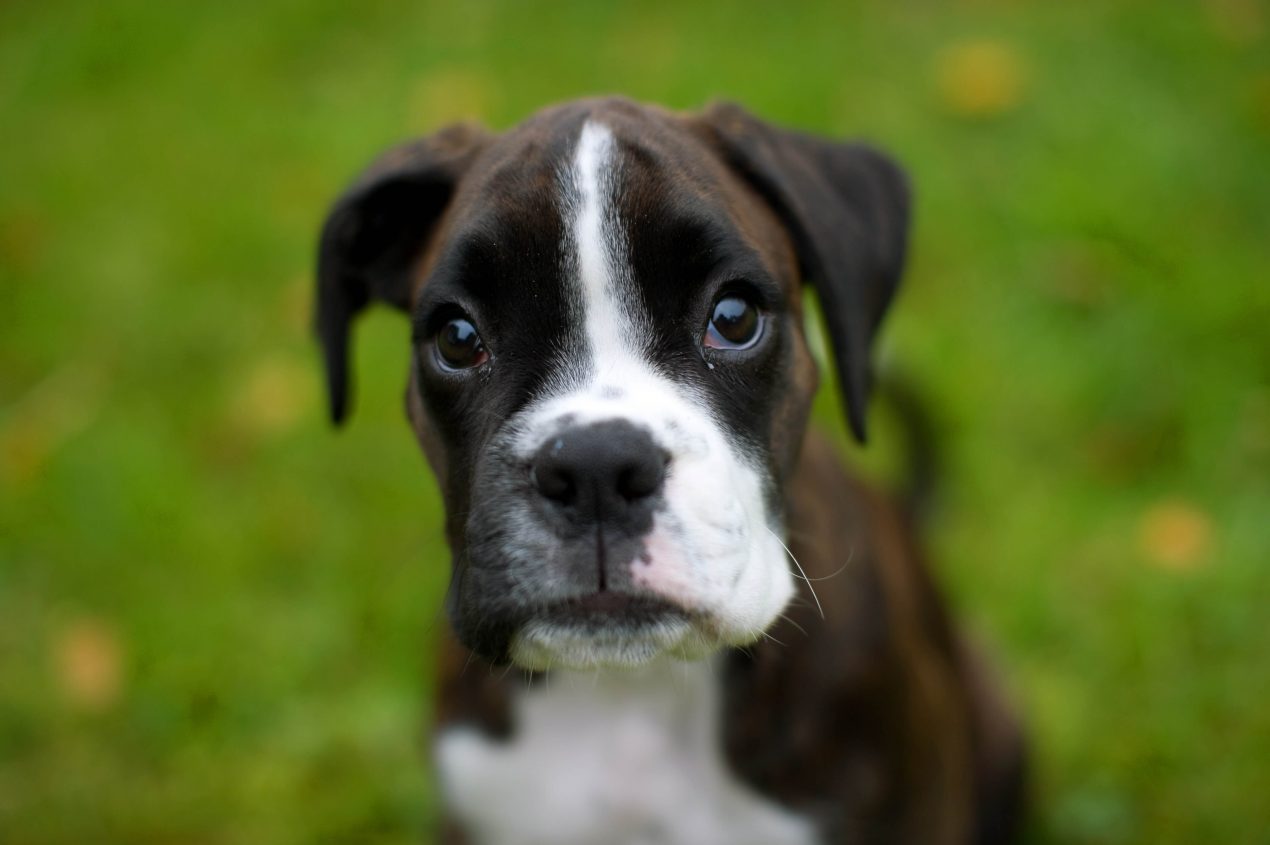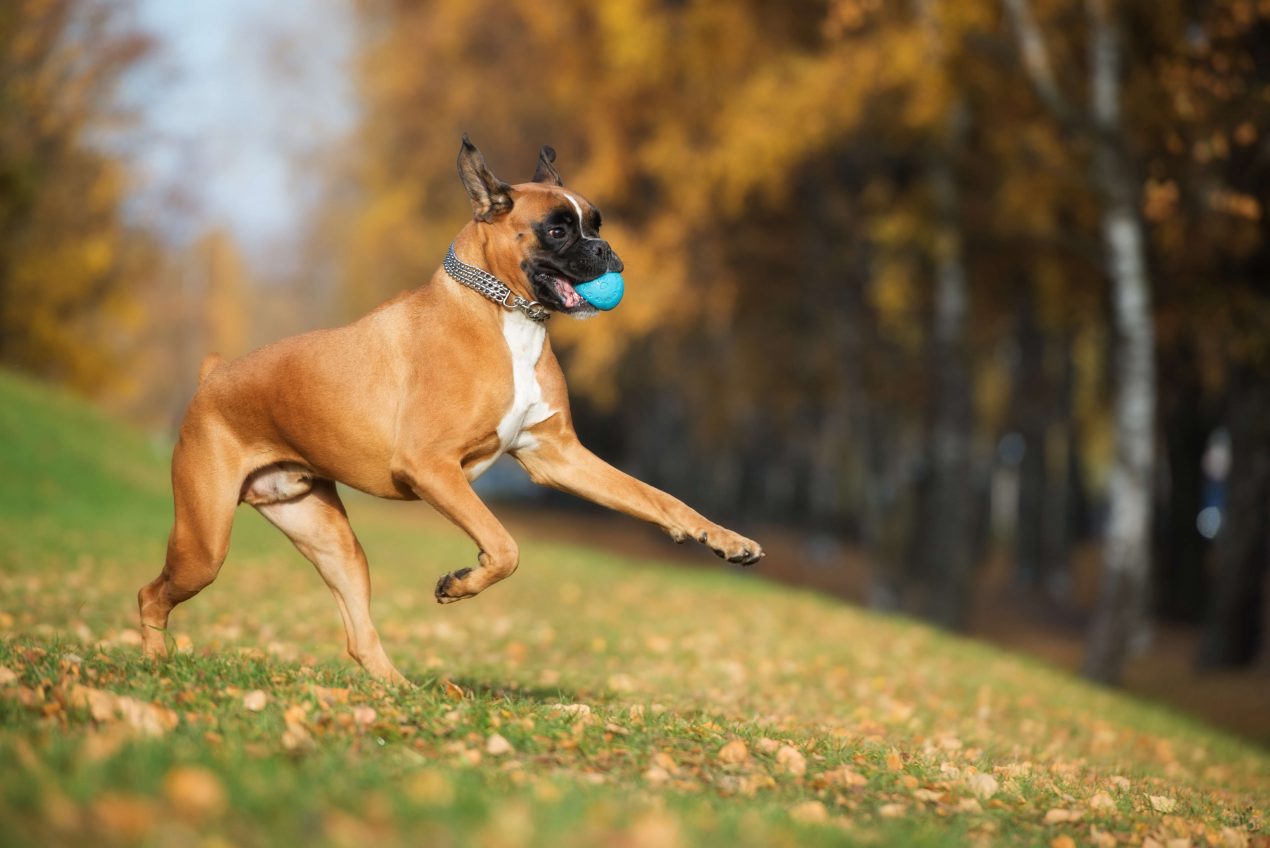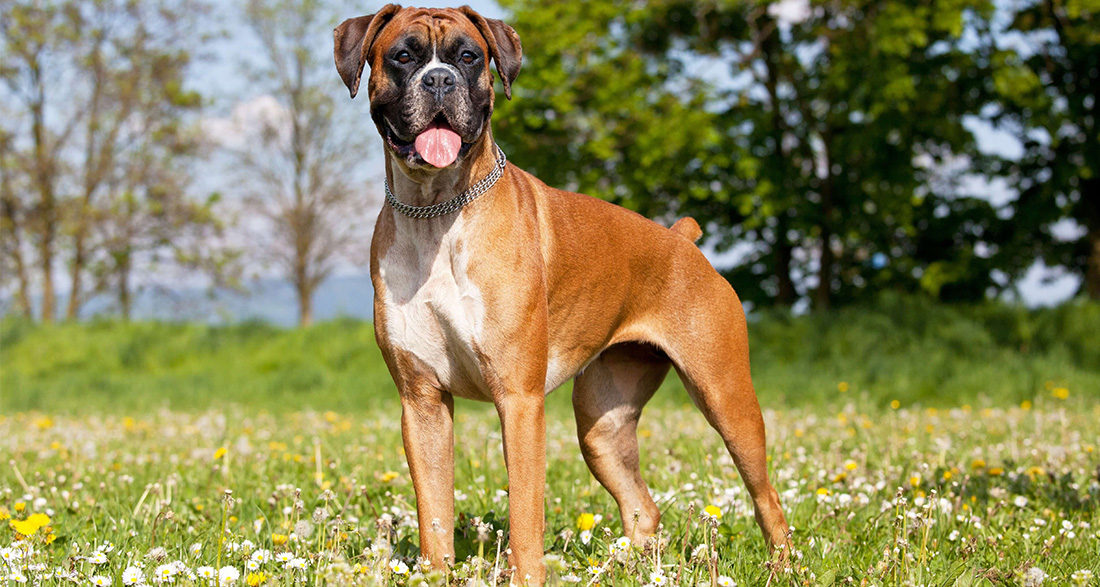The German Boxer is a playful and affectionate dog found in many German and American households. In the profile, you’ll find all the information you need about this breed.
History of the German Boxer
Originally, the German Boxer descended from the now-extinct bull and bear baiters. European nobles in the Middle Ages bred these dogs specifically for bear and wild boar hunting. The broad mouth with an underbite and the upturned nose allowed the dog to continue breathing while holding onto prey. After the dissolution of the principalities and the invention of firearms, hunting dogs gradually fell out of fashion. Only a few private individuals kept a bull baiter as a guard and protection dog.
Unfortunately, Germans also used the dog for bloody show fights against bulls or other dogs. Around 1850, some breeders began crossing the Brabanter Bull Baiter with English Bulldogs, resulting in the German Boxer. The newly established German Boxer Club specialized in breeding dogs with a friendly disposition. Internationally, the FCI classifies the Boxer in Group 2, Section 2.1 “Molossoid Breeds.”
Breed Overview
GROUP: Working
HEIGHT: 21 to 25 inches
WEIGHT: 50 to 80 pounds
COAT: Short, smooth
COAT COLOR: Typically fawn, brindle, or white, can have a black mask and/or white markings
LIFE SPAN: 10 to 12 years
TEMPERAMENT: Active, affectionate, playful, energetic
HYPOALLERGENIC: No
ORIGIN: Germany
Traits and Characteristics
A German Boxer is a well-balanced and sociable dog that learns quickly. It has a strong play drive and a high level of activity that it maintains even in old age. With its friendly nature, it makes an excellent companion for children. If you’re wondering, “Can a Boxer be dangerous?” we cannot speak for all members of the breed. The dog is initially distrustful of strangers but never aggressive or prone to biting. Nevertheless, it is a good watchdog that diligently protects its family and territory. However, are Boxers beginner dogs?
The intelligent Boxer is not easily distracted and remains focused when given a task. However, if a command does not seem reasonable to him, the dog may be stubborn and prefer to do its own thing. The combination of stubbornness and temperament definitely does not make it a beginner dog. With the appropriate training and socialization, a German Boxer will be a great and loyal companion for everyday life.
| Affection Level | High |
| Friendliness | High |
| Kid-Friendly | High |
| Pet-Friendly | Medium |
| Exercise Needs | High |
| Playfulness | High |
| Energy Level | High |
| Trainability | High |
| Intelligence | Medium |
| Tendency to Bark | Medium |
| Amount of Shedding | Medium |
How to Care for a German Boxer?
Considerations Before Acquisition:
Before getting a German Boxer, you should be sure that the breed is right for you. After all, you’re committing to the animal for the next 10 to 12 years and want to provide it with appropriate care. If you’re willing to invest a lot of time in exercising and engaging the dog, you’re already on the right track. Additionally, you need to familiarize yourself with the breed’s characteristics and ensure that the whole family agrees with the purchase.

If you’ve decided on a Boxer puppy, you should look for a reputable breeder. It’s best if they’re affiliated with the American Boxer Club and have experience in breeding. And how much does a Boxer cost? For a purebred and healthy puppy, you can expect prices ranging from $1000 to $1400. You can save money by adopting a German Boxer or a mix from a shelter.
There are always unfortunate Boxers who have fallen into trouble through no fault of their own. However, you should stay away from cheap offers on the internet, as the dogs are usually born under the worst conditions and serve solely as a source of income. Likewise, make sure that the Boxer is not a result of breeding for extreme features like an excessively shortened muzzle or a too thin tail.
Training and Puppy Development
The German Boxer is a breed that matures very slowly and is considered fully grown only at the age of three. So, you should not rush things and should not overwhelm him. As a puppy, he needs good socialization, as young Boxers tend to “box” other dogs to invite them to play. Unfortunately, many other dogs don’t understand this behavior and feel threatened. You can best solve this communication problem by allowing the puppy to interact with other dogs early on in a puppy school. When training a German Boxer puppy, always focus on being positive and never apply too much pressure. The Boxer can be quite stubborn, so you’ll only achieve your goals with consistency and patience.

Activities and Stimulation
The German Boxer is an active and playful dog that requires a lot of mental stimulation. He is up for long walks as well as hiking, jogging, or cycling. Additionally, he absolutely loves any kind of play and is particularly enthusiastic about ball and tug-of-war games. Contact with other dogs, with whom he can let off steam, is particularly important. Due to his character, he is also ideal as a guard, companion, and sports dog.
If you want to elevate your dog’s training to a professional level, you can train the Boxer as a recognized service dog, such as a search and rescue dog. In addition to enough physical activity, the German Boxer also needs an appropriate amount of mental stimulation. With a little creativity and the right tools, you can easily keep your dog satisfied.
Interesting Facts
Did you know?
- The German Boxer is a close relative of the Great Dane.
- Many US celebrities are fans of the German Boxer. Kim Kardashian, Justin Timberlake, Cameron Diaz, Jessica Biel, Hugh Jackman, and George Clooney each own a representative of the breed.
- During World War II, many German Boxers served at the front as military dogs.
- Due to their anatomy, the breed tends to drool and snore.
German Boxers in Film and Television:
The German Boxer is a playful and lovable dog, which the film industry has also noticed. In the US children’s film “Good Boy!” from 2003, a German Boxer plays a pivotal role. The German breed is also a sought-after actor in various English commercials. Companies like Seresto, Clearscore, and John Lewis each feature a representative of the breed in their advertisements. The John Lewis Christmas ad from 2016, featuring a Boxer named Buster on a trampoline, gained particular attention.
Do you also have a German Boxer or are you planning to get one soon? Share with me in the comments what makes the Boxer so special!


